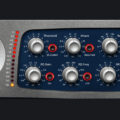I received a request to review the newly released Alkane saturator from the emerging brand Kalifornia Dynamics on the 3rd. I had already heard of this product, Alkane, last month.
I monitor newly released plugins daily through sites like KVR Audio, Gearspace, etc. As countless free and paid plugins hit the market daily, each uses different tactics to stand out.
Saturation plugins have become indispensable tools in modern DAW-based music production. Therefore, Alkane, which combines four types of saturators into one, is noteworthy on its own. Let's delve into what features this product offers.

I received a Not For Resale (NFR) license from Kalifornia Dynamics to conduct the test.
Contents
What is Saturation?
Saturation refers to the 'saturated state', where distortion occurs when a certain amount of signal is introduced into an analog device, resulting in pleasant harmonics and clipping.
In the digital music production process, one often experiences a feeling that the sound is 'cold' or 'dry'. In such cases, saturation plugins that mimic the characteristics of analog devices are frequently used.
Design
The design of Alkane's interface is straightforward. I don't dislike plugins adorned with fancy graphics. Rather, products like Alkane, which mimic various hardware saturations, benefit from graphics that at least vaguely resemble the respective hardware.
The display window on the right features a spectrogram. Below it, the EQ depicts the low frequencies on the left and high frequencies on the right, though the spectrogram reverses this. As saturation increases, the waveform in the spectrogram becomes more rounded, indicating clipping visually.

Interface
The interface is designed for easy navigation. By turning the COLOR knob, you can add saturation, while adjusting the OUTPUT compensates for increased volume. If necessary, raising the INPUT can make Alkane more active. The level meters on both sides provide visual feedback on the input and output gain.

The 'Thud' and 'Shine' functions may seem unfamiliar. Thud emphasizes low frequencies, while Shine accentuates or attenuates high frequencies, influencing saturation response as well. It feels like applying a two-stage saturation alongside the COLOR knob.
Audio Quality
Alkane offers four saturation models: vacuum tube, tape, transformer, and Japanese synthesizer circuit. While the website hints that these are modeled after specific hardware, it doesn't explicitly mention the products. Particularly, the fourth button 'Japanese' synthesizer circuit piques curiosity about its sound.

Saturation adjustment with the COLOR knob allows for subtle to aggressive saturation control. While I'm not certain if the actual products modeled by Kalifornia Dynamics behaved similarly, Alkane feels more focused on modern usability than precise analog emulation.
Audio Samples




In the 'Synth' model, excessive distortion occurs even if the COLOR knob is slightly increased. When used on sources with short transients, such as drums, it was possible to create interesting sounds.

Functionality
Using the DRY/WET knob, you can blend the desired amount of saturation. The EQ provides graphical feedback on curve changes, making it convenient even for beginners.
One drawback is the lack of an Auto Gain feature. As you increase the COLOR knob, the overall volume rises. So you need to reduce OUTPUT.
Alkane offers a variety of sounds, from subtle mastering saturation to pronounced distortion, catering to diverse purposes and sound types.
Price
The biggest point of contention is the price. Surprisingly, this plugin is priced at $299, which is relatively high compared to renowned saturators on the market (Decapitator $199, Saturn 2 €129, RC-20 $99.95, HG-2MS $79.99).
While it's understandable that combining four saturators might justify the price, having four saturators doesn't necessarily mean Alkane's utility is quadrupled. If each module had its own interface and operation, it might have been different, but Alkane feels like one saturator with four flavors.

Therefore, in terms of price, Alkane loses its competitiveness. However, considering saturation is somewhat of a personal preference, it seems aimed at users who purely 'love the sound'.
Alkane offers a 14-day free trial, so it's worth evaluating its value after using it extensively during the trial period.
It seems Kalifornia Dynamics is betting solely on 'sound' without relying on brand power, captivating design, or aggressive pricing. Keeping this in mind, I look forward to the next plugins Kalifornia Dynamics will release.




